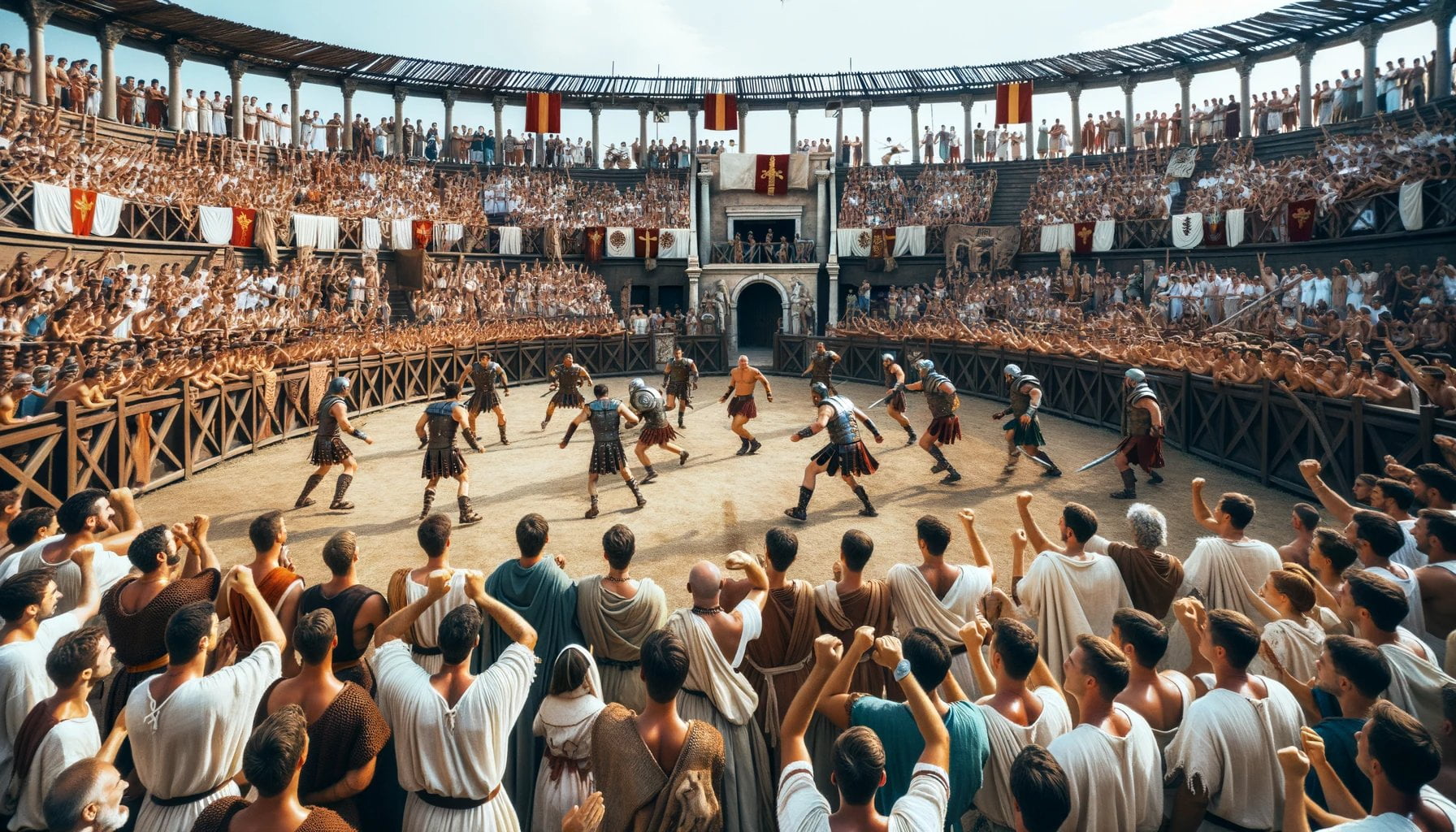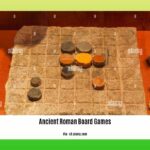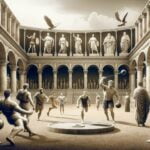The Profound Impact of Games in Ancient Rome explores the fascinating world of gaming in one of history’s most renowned civilizations. From gladiatorial battles and chariot racing to board games and dice games, this article delves into the diverse array of games enjoyed by Romans. Through meticulous research and a passion for ancient civilizations, we uncover how these games shaped social dynamics, reflected cultural values, and provided entertainment to people from all walks of life. Discover the profound influence of games on the lives of Ancient Romans and gain a deeper understanding of this captivating era.
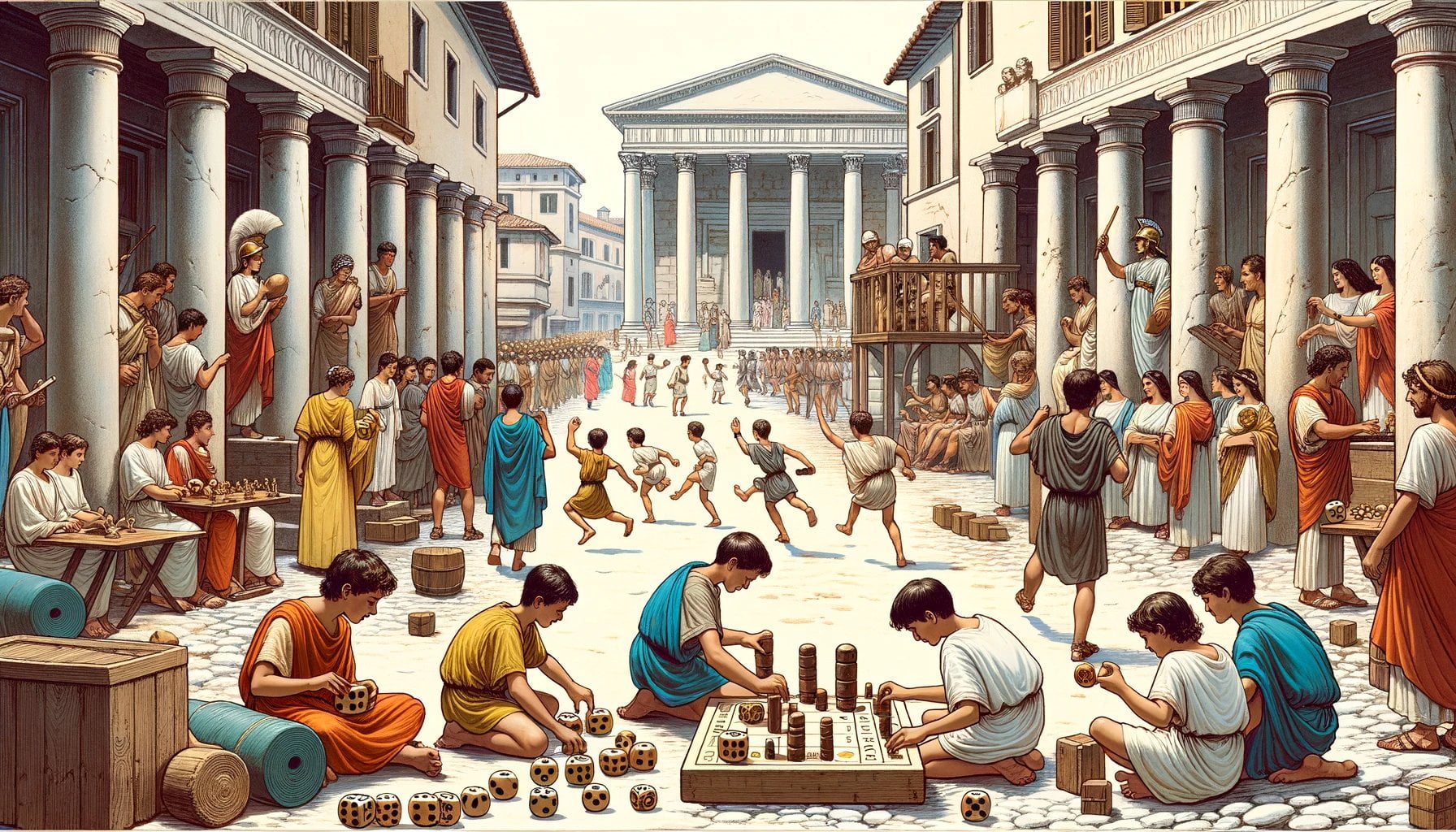
Key Takeaways:
- Ancient Roman games included a variety of entertainment options such as Latrunculi, Tali and Tesserae, Pilae, Par Impar, Trochus, and Micatio.
- These games provided entertainment for both adults and children in ancient Rome, with prizes often including money or materials.
- Men and boys were the main participants in these games, as women and girls were typically not allowed to play.
- Each game had specific rules and scoring systems, such as capturing pieces in Latrunculi or rolling certain combinations of dice in Tali and Tesserae.
- Toys such as tops, marbles, dolls, and swings were also popular among children in ancient Rome.
- Gambling and betting games were prevalent, but heavily regulated, although enforcement of laws was inconsistent.
- These games and activities shed light on the cultural practices and leisure activities of ancient Romans.
Games in Ancient Rome
In ancient Rome, games played a significant role in providing entertainment and leisure for people of all ages and social classes. These games ranged from physical contests like gladiatorial battles and chariot racing to strategic board games such as ludus latrunculorum and dice games like tesserae. Let’s dive deeper into the profound impact that games had on the lives of Ancient Romans.
Variety of Games
Ancient Romans had a wide array of games to choose from, catering to different interests and abilities. Games like Latrunculi, Tali and Tesserae, Pilae, Par Impar, Trochus, and Micatio offered diverse forms of entertainment. Each game had its own rules and scoring systems, providing players with unique challenges and opportunities for skillful gameplay.
To gain a better understanding of these ancient Roman games, the Maria Milani website offers a comprehensive overview, including rules and descriptions. The World History Encyclopedia also explores the role of athletics, leisure, and entertainment in ancient Rome, shedding light on popular games and activities.
Cultural Significance
Games in ancient Rome were not just about amusement; they shaped social dynamics and reflected cultural values. These games served as a form of escapism for the Roman citizens, allowing them to temporarily break away from the realities of their daily lives. They provided an avenue for social interaction and bonding among participants and spectators alike.
In addition, games played a crucial role in defining social hierarchies and reinforcing class distinctions. While games were enjoyed by people from all social strata, certain games were predominantly played by specific social groups. For example, gladiatorial battles were mainly watched by the general public, while chariot racing was popular among the elite.
Prizes and Participants
Prizes in ancient Roman games varied depending on the game. Winners could earn money, valuable materials, or recognition for their achievements. However, it is important to note that not all games were open to everyone. Women and girls were typically not allowed to participate, with the majority of players being men and boys.
Toys and Games for Children
Children in ancient Rome also had their own toys and games to enjoy. Tops, marbles, dolls, and swings were among the toys that provided entertainment for Roman kids. These toys not only served as objects of play but also fostered the development of skills and imagination.
Gambling and Betting
Apart from organized games, gambling and betting were prevalent pastimes in ancient Rome. While they were heavily regulated, the enforcement of laws was often lenient. Gambling and betting were popular across all social classes, from common citizens to Roman emperors like Augustus and Claudius. However, attempts to cheat in dice games to win money were not uncommon, revealing the allure and risk associated with gambling in ancient Rome.
Unveiling Ancient Roman Culture
By examining the games and entertainment enjoyed by ancient Romans, we gain valuable insights into their cultural practices and leisure activities. Games played a pivotal role in shaping the lives of individuals, fostering social connections, and reinforcing social hierarchies. Through meticulous research and a profound enthusiasm for ancient civilizations, we can fully appreciate the profound impact that games had on Ancient Rome.
Sources:
– Mariamilani.com. “Ancient Roman Games | Games in Ancient Rome – Maria Milani.”
– World History Encyclopedia. “Athletics, Leisure, and Entertainment in Ancient Rome.”
Poetry in ancient Rome was a vibrant and celebrated art form, capturing the emotions and stories of the people. Explore the fascinating world of poetry in ancient Rome by clicking here.
Discover the hidden gems and quaint villages that once thrived in the heart of ancient Rome. Immerse yourself in their rich history and charm by clicking here.
Uncover the invaders who shaped the destiny of ancient Rome, leaving an indelible mark on its history. Click here to learn more about these legendary conquerors.
Step into the shoes of a praetor and experience the power and influence they held in ancient Rome. Dive into the world of ancient politics by clicking here.
Travel back in time and witness the epic battles that defined ancient Rome. Click here to delve into the strategies, legends, and heroes of this remarkable era.
Unveil the graceful and captivating dance traditions of ancient Rome. Experience the beauty and rhythm of ancient Roman dances by clicking here.
Chariot Racing in Ancient Rome: A Thrilling Spectacle that Shaped Roman Culture
Chariot racing was more than just a sport in ancient Rome. It was a thrilling spectacle that captivated the masses and shaped the culture of the Roman society. Here are some key points about the significance of chariot racing in Roman society:
- Integration into Roman Festivals: Chariot racing played a significant role in Roman festivals, particularly the Ludi Romani, which were games held in honor of the chief Roman god, Jupiter Optimus Maximus. These races were closely associated with Greek religious festivals as well.
- Low Social Status of Chariot Drivers: Despite being essential to the races, chariot drivers had low social status in Roman society. However, they were celebrated for their skills and bravery on the racing track.
- Popularity and Cultural Significance: Chariot racing quickly became the most popular sporting event in ancient Rome. It was attended by people from all walks of life and served as a symbol of power, populism, and mass culture.
- The Circus Maximus: The races took place at the Circus Maximus, a massive racetrack located in Rome. This colossal structure, dating back to the city’s founder Romulus, provided a dangerous and thrilling setting for the races.
- Integration into the Olympic Games: Chariot racing was not limited to Rome; it was also a prominent feature of the ancient Olympic Games and other Greek religious festivals. This showcased the skills of the charioteers on an international level.
Chariot racing in ancient Rome left a lasting impact on the society. It united both the lower and elite classes, provided entertainment, and acted as a way to honor the gods. The sport’s influence extended beyond the race track, shaping the cultural fabric of ancient Rome.
Key Takeaways:
– Chariot racing was integrated into Roman festivals and played a significant role in religious celebrations.
– Chariot drivers, despite their low social status, were celebrated for their skills and bravery.
– The popularity of chariot racing made it a symbol of power, populism, and mass culture.
– Races took place at the dangerous Circus Maximus, a massive racetrack dating back to Romulus.
– Chariot racing was also a prominent feature of the ancient Olympic Games and Greek religious festivals.
To learn more about the significance of chariot racing in Roman society, you can visit the following sources:
Popular Board Games and Their Cultural Implications
Ancient Rome was a civilization rich in culture and entertainment. From the grand spectacles of gladiator battles and chariot racing to the intimate world of board games, games played a significant role in the lives of Romans. These popular board games not only provided amusement and leisure but also shaped social dynamics and reflected cultural values.
Ludus Latrunculorum, also known as “Latrunculi,” was one of the most popular board games played in the Roman Empire. While the exact rules of the game have been lost to history, it is believed to have been a strategic game similar to checkers. This game required careful planning and cunning, reflecting the Romans’ appreciation for strategy and tactics in both war and everyday life.
Another widely enjoyed game was Ludus Calculorum, which encompassed all board games that used pieces on grids. This term translates to “game of stones,” highlighting the simplicity and elemental nature of these games. Like Ludus Latrunculorum, Ludus Calculorum emphasized strategic thinking, offering players a chance to test and develop their mental agility.
The Roman version of backgammon, called Duodecim Scripta, combined elements of both board games and dice games. The game board consisted of three rows of twelve, and players used dice to determine their moves. Duodecim Scripta provided a blend of luck and strategy, captivating players with its intriguing gameplay and engaging challenges.
Tesserae, on the other hand, referred to Roman dice and the diverse range of games played with them. These dice were specially designed with opposing sides that would always add up to a specific number, adding an element of chance to the gameplay. Tesserae allowed players to indulge in the exciting world of gambling and betting, reflecting the Romans’ fascination with risk-taking and games of chance.
The Romans also had Tali, which were four-sided dice shaped like small pyramids. While there are few written examples of their use in games, it is believed that Tali were used for gameplay as well as divination purposes. These unique dice offered a glimpse into the mystical and superstitious beliefs of the ancient Romans.
It is important to note that the specific rules and gameplay of these ancient Roman board games are not fully known due to limited historical information. However, their popularity is evident from their mention in historical records and archaeological findings.
Key Takeaways:
– Ancient Romans enjoyed a variety of board games, including Ludus Latrunculorum, Ludus Calculorum, Duodecim Scripta, Tesserae, and Tali.
– These board games provided entertainment, socialization, and reflected the Romans’ cultural values and love for strategy, chance, and risk-taking.
– While the exact rules of ancient Roman board games are unknown, their popularity is evident in historical records and archaeological evidence.
[^1^]: The 8 Best Ancient Roman Board Games – History Hippo
[^2^]: Best Roman-themed Games | BoardGameGeek
The Role of Dice Games in Roman Social Interactions
The ancient Romans had a deep appreciation for games and gambling, and dice games held a special significance within their society. These games played a crucial role in shaping social interactions and fostering a sense of unity among individuals from various backgrounds. Let’s explore the historical origins, importance, and function of dice games in ancient Roman society.
Historical Origins of Dice Games
Dice games have a long history, with evidence of their existence dating back to ancient Egypt around 3,000 BC. The Romans adopted two popular dice games known as Tali and Tesserae. Tali, originally from Greece, involved the use of four dice made of animal bones. Tesserae, on the other hand, utilized dice to determine the movement of game pieces on a board.
The Use of Dice Towers
To ensure fairness in dice rolls, ancient Romans introduced the use of “dice towers.” These towers, made of bone and adorned with intricate designs, stood about 7.5 inches tall. By tossing the dice into the top of the tower, their passage down the ramps was believed to create a fair roll. The use of dice towers reflected the Romans’ dedication to fairness and preventing cheating in their games of chance.
The Significance of Dice Games in Roman Society
Dice games held great importance in Roman society and were enjoyed by people across different social classes. Gambling, although technically illegal, was rampant among both the lower and upper classes. Lower-class Romans often engaged in street games and placed bets, while the wealthy had dedicated gaming rooms in their villas.
The Role of Dice in Social Interactions
Dice games served as a common ground for people from different backgrounds to come together and engage in friendly competition. These games provided not only entertainment but also carried social and spiritual significance. The outcomes of dice games were often believed to be influenced by the will of the gods, and success in these games was seen as bringing favor from the divine. Thus, participating in dice games created opportunities for social bonding and connection.
Key Takeaways:
– Dice games, such as Tali and Tesserae, held historical origins dating back to ancient Egypt and Greece.
– The use of dice towers demonstrated the Romans’ emphasis on fairness in gaming.
– Dice games provided a common ground for people from different social classes to engage in friendly competition.
– Participating in dice games not only offered entertainment but also carried social and spiritual significance.
– The outcomes of dice games were often seen as influenced by the will of the gods.
Citation:
– University of Warwick. “Just a Game? An ancient dice tower and Roman society.”
– Popular Mechanics. “Why Ancient Romans Used Lopsided Dice.”
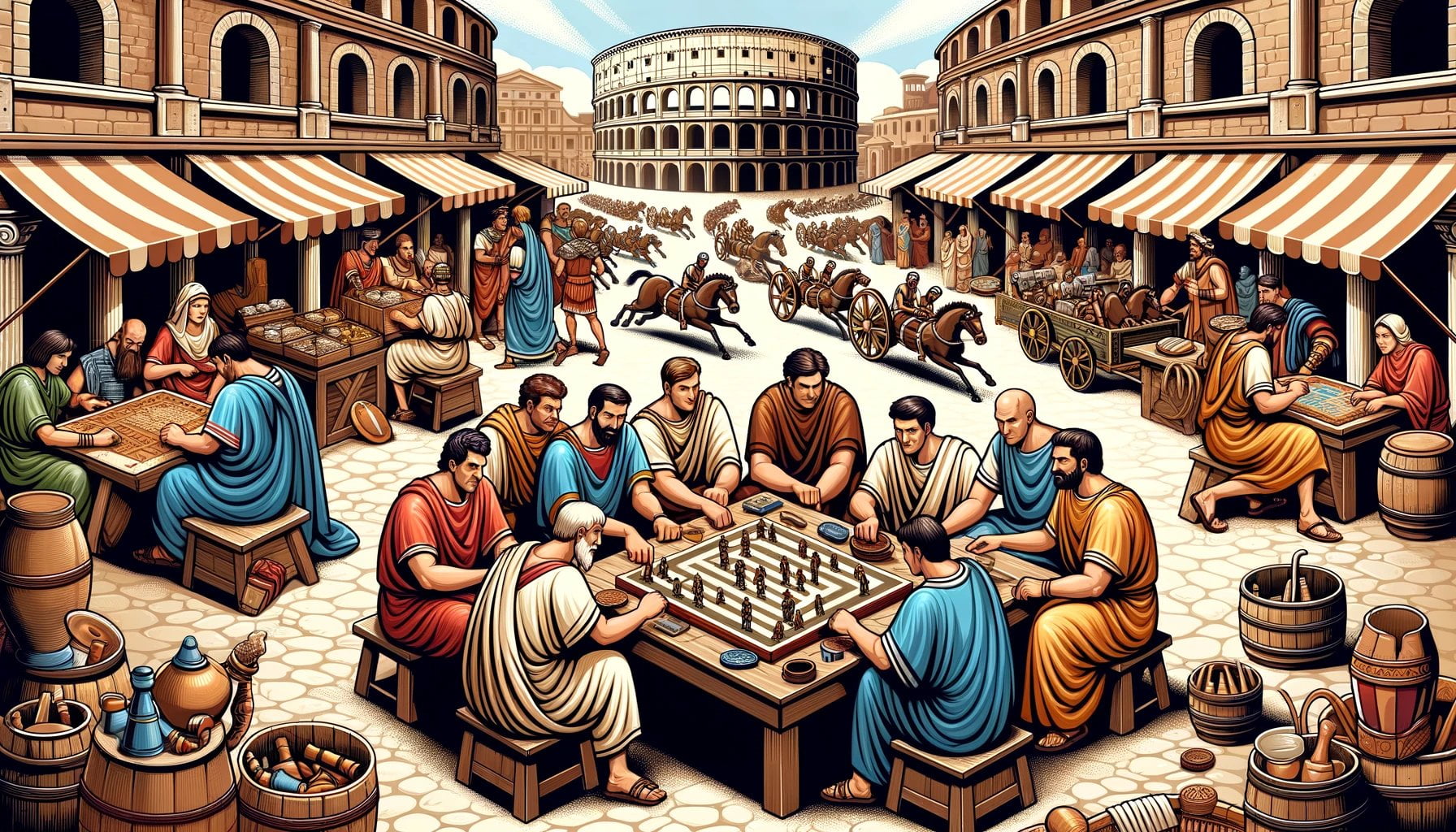
FAQ
Q1: What were some popular games in ancient Rome?
A1: Some popular games in ancient Rome included chariot racing, gladiatorial battles, board games like ludus latrunculorum, and dice games such as tesserae and tali.
Q2: Who participated in the ancient Roman games?
A2: The athletes who participated in the ancient Roman games were mainly men and boys, as women and girls were typically not allowed to play.
Q3: What were the prizes for winning the games?
A3: The prizes for winning the games varied depending on the game, but they often included money or materials.
Q4: Were there any regulations on gambling and betting in ancient Rome?
A4: Gambling and betting were popular games in ancient Rome, but they were heavily regulated, although laws were often not enforced.
Q5: What role did games play in ancient Roman society?
A5: Games in ancient Rome provided entertainment and leisure for people of all ages and social classes. They shaped social dynamics, reflected cultural values, and offered a means of socializing and connecting with the divine.
